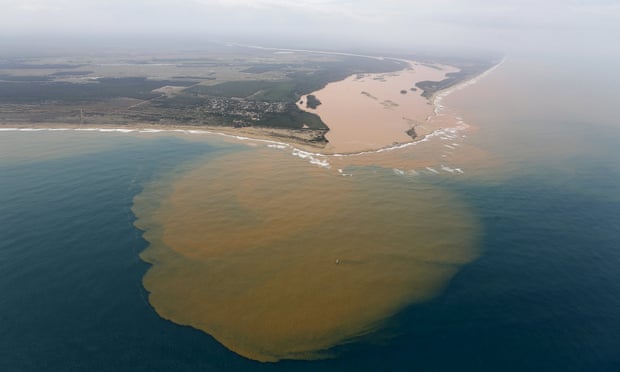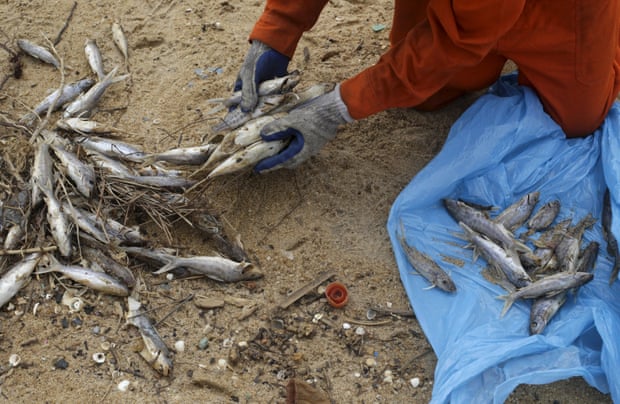According to projections from Brazil’s environment ministry, the tide is expected to spread along 5.5-mile (9km) stretch of the coastline, threatening the Comboios nature reserve, one of the only regular nesting sites for the endangered leatherback turtle.
“I don’t know what to say. It’s awful; it’s a calamity,” Joca Thome, the national coordinator of the marine conservation organisation Tamar, told the press after flying over the area. “It looks like brown gelatin spreading out to sea.”

An aerial view of the Rio Doce at an area where the river joins the sea, on the coast of Espírito Santo in Regência village. Photograph: Ricardo Moraes/Reuters
Around 50m cubic metres of mining residue has been working its way down the Rio Doce since the accident at the Fundão dam, controlled by the mining company Samarco, on 5 November.
The mud has extinguished vast amounts of plant and animal life along a 400-mile (650km) stretch of the river, with the heightened turbidity drastically reducing the levels of oxygen in the water.
Concern over toxins in the mining residue has led the national water agency, ANA, to ban the use of the river water for human consumption. Hundreds of thousands of residents in the area are still dependent on supplies of bottled water.
Dramatic footage shows the aftermath of a burst dam in south-eastern Brazil, which left homes and streets flooded
Over the past few days, Samarco, a joint venture between the Brazilian firm Vale and the Anglo-Australian company BHP Billiton, has contracted fishermen in the coastal village of Regência to install protective barriers along the estuary of the Rio Doce.
Diggers have also been working to widen the mouth of the river to ensure that the mud drifts out to sea as quickly as possible, in the hope that the salinity and the volume of water will aid its rapid dispersal.
The water in the estuary began turning brown on Saturday afternoon, as a crowd of angry locals gathered by the village dock to watch. The first dead fish began floating to the surface on Sunday.

A local fisherman working for a company contracted by Samarco mine operator clears up dead fish found on the beach of Povoacao village. Photograph: Ricardo Moraes/Reuters
So far Samarco has agreed to pay R$1bn (US$250m) in cleanup costs and compensation, as well as a fine of R$250m (US$66m) to the federal environmental agency Ibama.
A report in Monday’s Folha de São Paulo newspaper, however, suggested that from 2011 to 2014, only 8.7% of the fines issued by Ibama were collected.